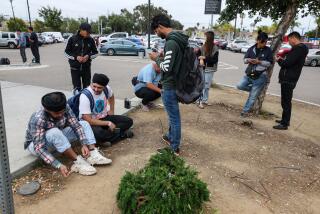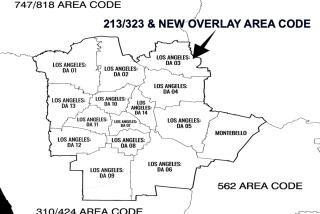Hold Off on Splitting 310, 909 Area Codes
- Share via
The California Public Utilities Commission is poised to split the 310 and 909 area codes this summer based on the “Chicken Little” threat that we are running out of phone numbers.
We have seen these tactics before, in 1999 when residents in 310 were threatened with an area-code split that proved unnecessary. Just as we discovered then, today there are more than enough phone numbers left in 310 to allow the PUC to hold off on splitting this area code. Moreover, two key Federal Communications Commission changes are in the works within the next five months that should help keep 310 intact.
Despite the facts, despite the enormous progress we’ve made in using phone numbers more efficiently and before the FCC’s new requirements can kick in to allow cell phone users to keep their phone numbers when they change carriers, the PUC may split the 310 area code.
California expanded from 13 area codes in 1997 to 25 by 2000. Industry projections originally called for a total of 41 California area codes by June 2003. Those estimates, derived from telephone company marketing and growth projections, proved inaccurate. The PUC studied the facts and found at least 3 million unused phone numbers in each California area code. We then stopped carriers from pulling 10,000 numbers at a time that sat unused in their inventories, and adopted common-sense number-use rules.
Changing the telephone number rules meant that unused numbers from one carrier were returned to a pool, to be available for use by other carriers. Because phone number conservation works, California still has only 25 area codes today.
The argument then, as now, is that changing your phone number is no big deal, and that Californians are accustomed to it. I disagree. Changing your phone number, in this era of automatically programmed computers, phones and databases, is more than just a monumental hassle. It imposes substantial costs to reprint business forms and stationery and change listings in specialized business directories. It can mean lost customers and suppliers. All this for the phone companies’ convenience and the ability to provide vanity and sequential phone numbers.
Now the cellular telephone carriers are back, trying to break California’s area codes apart -- in both 310, covering Malibu south to San Pedro and the coast east to Compton, and in 909, covering Big Bear, Riverside and Temecula -- by draining the 310 and 909 number pools to push the PUC to act.
These companies recently have pulled almost one-third of the remaining numbers from the 310 pool and over one-quarter of the remaining numbers in the 909 pool.
On May 1, the 310 area code contained more than 500,000 unused phone numbers, while 909 had more than 800,000 unused numbers in the pool. Immediately after the PUC published a proposal to split the 310 area code, cellular carriers pulled hundreds of thousands of unused numbers out of the 310 and 909 number pools, compared with an average monthly pull of less than 20,000 numbers.
Purportedly, this incredible taking of unused numbers was to provide gifts for dads and grads. A look behind the numbers tells a different story. In every other California area code, the take from those pools reflected usual rates. Instead of using this sudden May increase to justify splitting the 310 area code, we should question taking hundreds of thousands of unused 310 and 909 numbers out of circulation.
Before splitting the 310 area code, the PUC should at least wait until November, when the FCC requires the cellular companies to get in step with the rest of the telecommunications industry and make necessary software changes so all cellular customers can keep their numbers when they change carriers. This available technology will not only conserve California’s area codes but will enhance competition and customer choices.
The PUC faces a clear choice: We can split the 310 area code based on the limits of yesterday’s technologies and rules or we can wait a few months for technological advances to create a win-win for California businesses and families.
More to Read
Sign up for Essential California
The most important California stories and recommendations in your inbox every morning.
You may occasionally receive promotional content from the Los Angeles Times.













